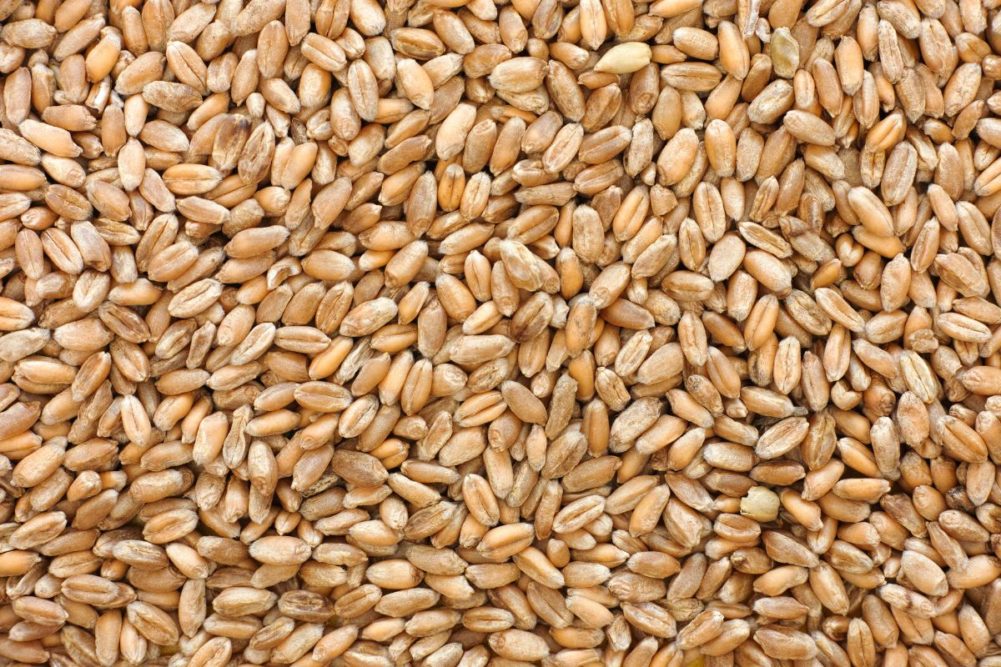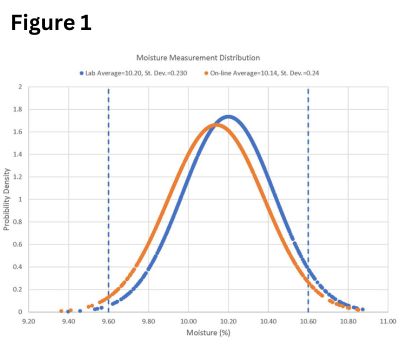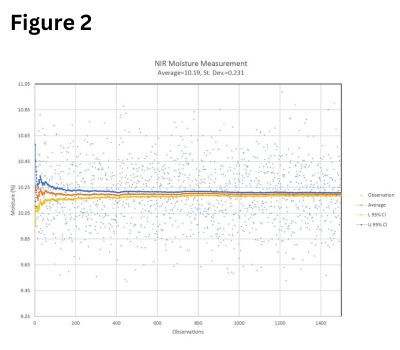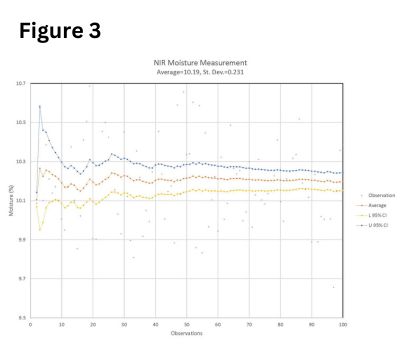
Milling Operations: Tempering process control
عمليات الطحن: التحكم في عملية الترطيب
KANSAS CITY, MISSOURI, US
https://www.world-grain.com/articles/19040-milling-operations-tempering-process-control
Credit: ©STEPAN POPOV - STOCK.ADOBE.COM
09.15.2023 By Jeff Gwirtz
The closing sentence of my article in the April 2023 issue of World Grain was: “You cannot manage what you cannot measure.” It often is attributed to W. Edwards Deming, the statistician and quality-control expert credited with having launched the Total Quality Management (TQM) movement, and at other times it is attributed to Peter Drucker, perhaps the world’s most famous management consultant ever.
كانت الجملة الختامية لمقالتي في عدد أبريل 2023 من World Grain هي: "لا يمكنك إدارة ما لا يمكنك قياسه". غالبا ما ينسب إلى دبليو إدواردز ديمينغ ، الإحصائي وخبير مراقبة الجودة الذي ينسب إليه الفضل في إطلاق حركة إدارة الجودة الشاملة (TQM) ، وفي أوقات أخرى ينسب إلى بيتر دراكر ، ربما أشهر مستشار إداري في العالم على الإطلاق.
Others have suggested that neither made such a statement as it is too simplistic and misleading. As Deming points out, nothing becomes important just because it can be measured, especially with little or no consideration of other data that is unknown or unknowable.
وأشار آخرون إلى أن أيا منهما لم يدل بمثل هذا البيان لأنه مفرط في التبسيط والتضليل. كما يشير ديمنج ، لا شيء يصبح مهما لمجرد أنه يمكن قياسه ، خاصة مع القليل من الاهتمام أو عدم النظر في البيانات الأخرى غير المعروفة أو غير الممكنة للمعروفة.
From a milling perspective, the benefit of uniform tempering or conditioning is well known and appreciated.
من منظور الطحن ، فإن فائدة الترطيب أو التكييف المثالى المنضبط معروفة جيدا ومقدرة.
However appreciated the process of tempering or conditioning is, its management and control often is compromised by the lack of data, improper interpretation of data, and human intervention, whether the conditioning system is manually controlled or automated.
على الرغم من تقدير عملية الترطيب أو التكييف ، إلا أن إدارتها والتحكم فيها غالبا ما تتعرض للخطر بسبب نقص البيانات ، والتفسير غير السليم للبيانات ، والتدخل البشري ، سواء تم التحكم في نظام التكييف يدويا أو آليا.
Manually controlled and monitored systems utilize limited data collection and analysis procedures often responding by making an adjustment and operating for a period before the next monitoring or sampling time. Between sampling periods, a significant amount of wheat passes through the system with some level of inherent moisture and flow rate variability. For example, in a 300-tonne-per-day day mill (approximately 5,000 cwt/day flour) 12.5 tonnes/hour of wheat is tempered.
تستخدم الأنظمة التي يتم التحكم فيها ومراقبتها يدويا إجراءات محدودة لجمع البيانات وتحليلها غالبا ما تستجيب عن طريق إجراء تعديل وتشغيلها لفترة قبل وقت المراقبة أو أخذ العينات التالي. بين فترات أخذ العينات ، تمر كمية كبيرة من القمح عبر النظام بمستوى معين من الرطوبة المتأصلة وتقلب معدل التدفق. على سبيل المثال ، في مطحنة يومية 300 طن في اليوم (حوالي 5000 cwt = 250 طن دقيق / اليوم) ويتم ترطيب 12.5 طن / ساعة من القمح.
On a per-minute basis, the wheat rate is significant at 208 kg/minute, 459.3 pounds/minute or 7.6 bushels/minute. Undoubtedly there is much that is unknown and unknowable about such a process such as the dry wheat flow rate and wheat moisture. The assumption of stability in dry wheat moisture content, dry wheat flow rate and water meter setting is not correct and is further compromised when tempered wheat moisture taken at B1 is used to adjust moisture addition.
على أساس الدقيقة ، يكون معدل القمح كبيرا عند 208 كجم / دقيقة أو 459.3 رطلا / دقيقة أو 7.6 بوشل / دقيقة. مما لا شك فيه أن هناك الكثير مما هو غير معروف وغير معروف حول مثل هذه العملية مثل معدل تدفق القمح الجاف ورطوبة القمح. إن افتراض الاستقرار في محتوى رطوبة القمح الجاف ومعدل تدفق القمح الجاف وإعداد عداد المياه غير صحيح ويتعرض لمزيد من التأثر عند استخدام رطوبة القمح المرطب المأخوذة عند B1 لضبط إضافة الرطوبة.
An individual moisture measurement is a spot observation of moisture content for a sample. Within a static 250-gram sample of wheat, an NIR taking 10 moisture measures may report a difference between the maximum and minimum moisture content of the 10 measurements as large as 0.5%, while the average difference across 50 or more samples is 0.2% or less. Clearly, moisture measurement within any wheat mass, no matter how small the sample, is inherently variable.
قياس الرطوبة الفردي هو ملاحظة موضعية لمحتوى الرطوبة للعينة. ضمن عينة ثابتة من القمح وزنها 250 جراما ، قد يبلغ تقرير NIR الذي يتخذ 10 مقاييس للرطوبة عن اختلاف بين الحد الأقصى والحد الأدنى لمحتوى الرطوبة في القياسات العشرة التي تصل إلى 0.5٪ ، في حين أن متوسط الفرق عبر 50 عينة أو أكثر هو 0.2٪ أو أقل. من الواضح أن قياس الرطوبة داخل أي كتلة قمح ، بغض النظر عن صغر حجم العينة ، متغير بطبيعته.
A single measurement ignores that variability and prevents us from understanding from what average value might the single observed moisture measurement represent. To provide a meaningful understanding and, hence, ability to manage the tempering process we must understand both the average and variability or standard deviation of the moisture measurement observations. More importantly, we should respond only to changes or movement in the average moisture value, which moves us away from our target value or set point as well as changes in measurement variability.
يتجاهل قياس واحد هذا التباين ويمنعنا من فهم متوسط القيمة التي قد يمثلها قياس الرطوبة المرصود الفردي. لتوفير فهم هادف ، وبالتالي القدرة على إدارة عملية الترطيب ، يجب أن نفهم كلا من المتوسط والتباين أو الانحراف المعياري لملاحظات قياس الرطوبة. والأهم من ذلك ، يجب أن نستجيب فقط للتغيرات أو الحركة في متوسط قيمة الرطوبة ، مما يبعدنا عن القيمة المستهدفة أو نقطة الضبط وكذلك التغيرات في تباين القياس.

توزيع قياس الرطوبة باستخدام طريقتين مختلفتين للقياس. | ©جيف جويرتز
Analyzing the data تحليل البيانات
Figure 1 compares two sets of moisture data for dry wheat using normal distributions based on nine measurements made using a Lab NIR and an online measuring device. In the graphic, the average and standard deviation are provided for each measurement system based on N=1500 observations. The mean value reported differs by 0.06% and the standard deviation, a measure of variability, is quite similar for both moisture measurement methods, averaging 0.235%. The moisture measurement distributions are neither statistically nor practically significantly different. The 95% Confidence Interval for individual moisture observations is approximately 10.2± 0.5%, while the 95% Confidence Interval for the mean value is 10.2± 0.01%.
يقارن الشكل 1 مجموعتين من بيانات الرطوبة للقمح الجاف باستخدام التوزيعات الطبيعية بناءا على تسع قياسات تم إجراؤها باستخدام مختبر NIR وجهاز قياس أون لاين . في الرسم ، يتم توفير المتوسط والانحراف المعياري لكل نظام قياس بناء على N = 1500 ملاحظة. يختلف متوسط القيمة المبلغ عنها بنسبة 0.06٪ والانحراف المعياري ، وهو مقياس للتغير ، مشابه تماما لكلتا طريقتي قياس الرطوبة ، بمتوسط 0.235٪. لا تختلف توزيعات قياس الرطوبة إحصائيا ولا عمليا بشكل كبير. يبلغ فاصل اليقين 95٪ لملاحظات الرطوبة الفردية حوالي 10.2± 0.5٪ ، بينما يبلغ فاصل اليقين 95٪ للقيمة المتوسطة 10.2± 0.01٪.
Sample measurements may vary between 9.6% to 10.6% within the same distribution whose average value is 10.2%. Adjusting moisture addition based on a single observation would not only be unwarranted but likely increase variability and widen the Confidence Interval about the mean value. Intervention is not warranted based on a single observation period.
قد تختلف قياسات العينة بين 9.6٪ إلى 10.6٪ داخل نفس التوزيع الذي يبلغ متوسط قيمته 10.2٪. لن يكون تعديل إضافة الرطوبة بناء على ملاحظة واحدة غير مبرر فحسب ، بل من المحتمل أن يزيد من التباين ويوسع فاصل اليقين حول القيمة المتوسطة. لا يوجد ما يبرر التدخل بناء على فترة مراقبة واحدة.
The ability to collect and analyze moisture data in a manual operation is undoubtedly a challenge. One might start with taking multiple samples, perhaps N=5 as might be done on a packaging line to monitor packaging line performance and record the average moisture and range between the minimum and maximum moisture value measured. Respond only to multiple consecutive increasing or decreasing changes in moisture measurement before adjusting water addition. Changes in the moisture range may reflect blending uniformity or bin changes that should be explored. Variability is endemic and will be observed. However, every change does not warrant adjustment.
لا شك أن القدرة على جمع بيانات الرطوبة وتحليلها في عملية يدوية تمثل تحديا. يمكن للمرء أن يبدأ بأخذ عينات متعددة ، ربما N = 5 كما يمكن القيام به على خط التعبئة لمراقبة أداء خط التعبئة والتغليف وتسجيل متوسط الرطوبة والنطاق بين الحد الأدنى والحد الأقصى لقيمة الرطوبة المقاسة. استجب فقط للتغيرات المتعددة المتتالية المتزايدة أو المتناقصة في قياس الرطوبة قبل ضبط إضافة الماء. قد تعكس التغييرات في نطاق الرطوبة توحيد المزج أو تغييرات الحاوية التي يجب استكشافها. التباين مستوطن وسيتم ملاحظته. ومع ذلك ، فإن كل تغيير لا يستدعي التعديل.

Individual observations, the average, and a 95% Confidence Interval for NIR moisture measurement of dry wheat is shown in Figure 2. As can be observed, the average values and confidence interval fall in a much narrower band than the individual observations. Imagine the frustration and extra work it takes to respond to single observations. Moreover, the distribution of individual observations would become much wider as would the confidence interval about the mean or average value. With limited observations, the impact would be even greater.
يظهر الشكل 2 الملاحظات الفردية والمتوسط وفاصل الثقة بنسبة 95٪ لقياس رطوبة NIR للقمح الجاف. كما يمكن ملاحظته ، يقع متوسط القيم وفاصل الثقة في نطاق أضيق بكثير من الملاحظات الفردية. تخيل الإحباط والعمل الإضافي الذي يتطلبه الرد على الملاحظات الفردية. وعلاوة على ذلك، سيصبح توزيع الملاحظات الفردية أوسع بكثير وكذلك فاصل الثقة بشأن متوسط أو متوسط القيمة. مع ملاحظات محدودة ، سيكون التأثير أكبر.
Figure 3 provides the average and a 95% Confidence Interval for NIR moisture measurement of dry wheat early observations shown in Figure 2. Given limited data points the estimate of the mean value varies more wildly as does the Confidence Interval for the mean value.
يقدم الشكل 3 المتوسط وفاصل الثقة 95٪ لقياس رطوبة NIR للملاحظات المبكرة للقمح الجاف الموضحة في الشكل 2. بالنظر إلى نقاط البيانات المحدودة ، يختلف تقدير القيمة المتوسطة بشكل أكبر كما هو الحال مع فاصل الثقة للقيمة المتوسطة.

ملاحظات قياس الرطوبة NIR ، متوسط و 95٪ فاصل ثقة القمح الجاف ، تستند التقديرات المبكرة إلى عدد محدود من الملاحظات. | ©جيف جويرتز
As can be observed beyond 30 to 40 observations, the estimated mean and Confidence Interval become more stable. Beyond this point, the average value and the 95% Confidence Interval variability reflects the inherent variability of the dry wheat mix rather than the impact of relying on limited sample data for the estimate of the average value its 95% Confidence Interval. As some may recall, N=30 is the trigger point for statistical analysis using sample statistical analysis (t-score) and population statistical analysis (Z-score). Repeated measures improve the calculated population mean and standard deviation estimate, providing a more reasonable assessment of product or system variability.
كما يمكن ملاحظته بعد 30 إلى 40 ملاحظة ، يصبح المتوسط المقدر وفاصل الثقة أكثر استقرارا. بعد هذه النقطة ، يعكس متوسط القيمة وتقلب فاصل الثقة 95٪ التباين المتأصل في مزيج القمح الجاف بدلا من تأثير الاعتماد على بيانات عينة محدودة لتقدير متوسط القيمة في فترة الثقة 95٪. كما قد يتذكر البعض ، N = 30 هي نقطة الانطلاق للتحليل الإحصائي باستخدام عينة التحليل الإحصائي (t-score) والتحليل الإحصائي للسكان (Z-score). تعمل المقاييس المتكررة على تحسين متوسط السكان المحسوب وتقدير الانحراف المعياري ، مما يوفر تقييما أكثر منطقية لتنوع المنتج أو النظام.
The ability to collect and analyze data manually is challenging, especially with scheduling of short grist or mill mix runs. Leveraging data collection and analysis across cumulative short runs of a given grist or mill mix may be a useful approach. Automation may allow for increased data collection, analysis, and most importantly on-screen reporting. Imagine a tempering process control system reporting real time data for dry wheat flow rate, dry wheat moisture and water addition rate and estimated tempered wheat moisture while considering any programed “offset.”
تعد القدرة على جمع البيانات وتحليلها يدويا أمرا صعبا ، خاصة مع جدولة عمليات تشغيل قصيرة أو مزيج المطحنة. قد تكون الاستفادة من جمع البيانات وتحليلها عبر فترات قصيرة تراكمية لمزيج معين من الطاحونة أو المطحنة نهجا مفيدا. قد تسمح الأتمتة بزيادة جمع البيانات وتحليلها والأهم من ذلك إعداد التقارير على الشاشة. تخيل نظام التحكم في عملية الترطيب الذي يبلغ عن بيانات في الوقت الفعلي لمعدل تدفق القمح الجاف / القمح الخام ورطوبة القمح الجاف / القمح الخام ومعدل إضافة الماء ورطوبة القمح المرطب المقدرة أثناء النظر في أي "تعويض" مبرمج.
To avoid the introduction of variation beyond the inherent variation of the tempering system, carefully consider the program of managing your automated tempering system with limited manual measurement. If the process is to be controlled, it is not simply a matter of taking measurements, it is taking the correct measurements sufficient to reflect the nature of the process. Only when sound measures are available should intervention be undertaken to manage the process.
لتجنب إدخال تباين يتجاوز الاختلاف المتأصل في نظام الترطيب ، فكر بعناية في برنامج إدارة نظام الترطيب الآلي الخاص بك بقياس يدوي محدود. إذا كان يجب التحكم في العملية ، فالأمر لا يتعلق ببساطة بأخذ القياسات ، بل أخذ القياسات الصحيحة الكافية لتعكس طبيعة العملية. ولا ينبغي التدخل لإدارة العملية إلا عندما تتوفر تدابير سليمة.
Jeff Gwirtz, a milling industry consultant, is president of JAG Services, Inc. He may be reached at jgwirtz@att.net.
Cpd : https://www.world-grain.com/articles/19040-milling-operations-tempering-process-control